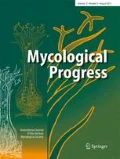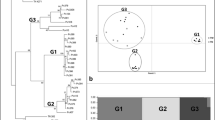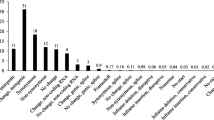Abstract
Phytophthora colocasiae is an important pathogen of taro and is widely distributed. Our goal was to develop whole genome sequence and single nucleotide polymorphism (SNP) markers to characterize historical and current populations from Hawaii (2010 and 2016, HA), historical isolates from Vietnam and China (2010, VN and CH) and current isolates from Nepal (2016, NEP). Seven isolates (VN = 2, CH = 1, HA = 1, NEP = 3) were sequenced (NCBI BioProject PRJNA378784) and compared using the reference genome of the closely related vegetable pathogen P. capsici. Genome-wide SNP analysis using 27,537 markers revealed genomes of diploid, triploid, tetraploid and higher ploidy. Ploidy varied within and between populations, with HA being primarily diploid, CH primarily triploid, VN containing diploid and triploid isolates, and NEP having predominantly triploid, tetraploid and higher ploidy. A total of 37 SNP markers were genotyped in 89 samples (grown in culture or directly from infected tissue) using targeted-sequencing. Analyses indicate a single clonal lineage dominated populations in HA from 2010 to 2016 and targeted-sequencing was useful to estimate ploidy. The implications for adaptation and evolution of P. colocasiae are discussed, as well as consequences for selection and breeding of resistant taro cultivars.





Similar content being viewed by others
References
Alby K, Bennett RJ (2009) Stress-induced phenotypic switching in Candida albicans. Mol Biol Cell 20:3178–3191
Ann P, Kao C, Ko W (1986) Mating-type distribution of Phytophthora colocasiae in Taiwan. Mycopathologia 93:193–194
Bandyopathy R, Sharma K, Onyeka TJ, Aregbesola A, Kumar PL (2011) First report of taro (Colocasia esculenta) leaf blight caused by Phytophthora colocasiae in Nigeria. Plant Dis 95:618. doi:10.1094/PDIS–12–10–0890
Berman J, Hadany L (2012) Does stress induce (para) sex? Implications for Candida albicans evolution. Trends Genet 28:197–203
Brooks F (2005) Taro leaf blight. The Plant Health Instructor. doi:10.1094/PHII2005053101
Carlson MO, Gazave E, Gore MA, Smart CD (2017) Temporal genetic dynamics of an experimental, biparental field population of Phytophthora capsici. Front Genet 8. doi:10.3389/fgene.2017.00026
FAO (2017) FAOSTAT. Available at http://www.fao.org/faostat/en/%23home
Huang A, Titchenal C, Meilleur B (2000) Nutrient composition of taro corms and breadfruit. J Food Compos Anal 13:859–864
Irwin SV, Kaufusi P, Banks K, de la Peña R, Cho JJ (1998) Molecular characterization of taro (Colocasia esculenta) using RAPD markers. Euphytica 99:183. doi:10.1023/a:1018309417762
Ko W (1979) Mating–type distribution of Phytophthora colocasiae on the island of Hawaii. Mycologia 71:434–437
Kreike CM, Van Eck HJ, Lebot V (2004) Genetic diversity of taro, Colocasia esculenta (L.) Schott, in Southeast Asia and the Pacific. Theor App Genet 109:761–768. doi:10.1007/s00122–004–1691–z
Kumar S, Stecher G, Tamura K (2016) MEGA7: molecular evolutionary genetics analysis version 7.0 for bigger datasets. Mol Biol Evol 33:1870–1874
Lamour K, Finley L (2006) A strategy for recovering high quality genomic DNA from a large number of Phytophthora isolates. Mycologia 98:514–517
Lebot V, Herail C, Gunua T, Pardales J, Prana M, Thongjiem M, Viet N (2003) Isozyme and RAPD variation among Phytophthora colocasiae isolates from south-east Asia and the Pacific. Plant Pathol 52:303–313
Li Y, Shen H, Zhou Q, Qian K, van der Lee T, Huang S (2016) Changing ploidy as a strategy; the Irish potato famine pathogen shifts ploidy in relation to its sexuality. Mol Plant Microbe In 30:45–52
McKenna A et al (2010) The genome analysis toolkit: a MapReduce framework for analyzing next–generation DNA sequencing data. Genome Res 20:1297–1303
Miller CD (1927) Food values of poi, taro, and limu. Bull Bishop Mus 37:1–25
Mishra AK, Sharma K, Misra RS (2010) Isozyme and PCR-based genotyping of epidemic Phytophthora colocasiae associated with taro leaf blight. Arc Phytopathol PFL 43:1367–1380
Miyasaka SC, Lamour K, Shintaku M, Shrestha S, Uchida J (2013) Taro leaf blight caused by Phytophthora colocasiae. In: Lamour K (ed) Phytophthora: a global perspective, 1st edn. CABI, Wallingford, pp 104–112
Nath VS, Senthil M, Hegde VM, Jeeva ML, Misra RS, Veena SS, Raj M (2013a) Genetic diversity of Phytophthora colocasiae isolates in India based on AFLP analysis. Biotech 3:297–305
Nath VS, Senthil M, Hegde VM, Jeeva ML, Misra RS, Veena SS, Raj M (2013b) Molecular evidence supports hypervariability in Phytophthora colocasiae associated with leaf blight of taro. Eur J Plant Pathol 136:483–494
Nei M, Kumar S (2000) Molecular evolution and phylogenetics. Oxford University Press, Oxford
Nelson S, Brooks F, Teves G (2011) Taro leaf blight in Hawaii. Plant disease bulletin no PD–71, University of Hawaii, Manoa
Omane E, Oduro KA, Cornelius EW, Opoku IY, Akrofi AY, Sharma K, Kumar PL, Bandyopadhyay R (2012) First report of leaf blight of taro (Colocasiae esculenta) caused by Phytophthora colocasiae in Ghana. Plant Dis 96:292. doi:10.1094/PDIS–09–11–0789
Pandey YR, Rijal DK, Sthapit B (1998) Diversity of taro and on-farm conservation through use in Nepal. Ethnobotany and genetic diversity of Asian taro with focus on China. In: Zhu D, Zhou M, Pablo E (eds) Proceedings of the symposium on ethnobotanical and genetic diversity study of taro in China: approaches for the conservation and use of taro genetic resources, 10–12 November, 1998. Laiyang Agricultural College, Laiyang, pp 18–25
Raciborski M (1900) Parasitic algae and fungi, java. Batavia Bull N Y State Mus 19:189
Rijal DK, Sthapit BR, Rana RB, Jarvis DI (2003) Adaptation and uses of taro diversity in agroecosystems of Nepal in: Sthapit B, Upadhyay M, Baniya B, Subedi a, Joshi B (eds) on–farm management of agricultural biodiversity in Nepal. Proceedings of National Workshop, 24–26 April 2001, Lumle, Nepal, pp 29–36
Selmecki AM et al (2015) Polyploidy can drive rapid adaptation in yeast. Nature 519:349–352
Shrestha S, Hu J, Fryxell RT, Mudge J, Lamour K (2014) SNP markers identify widely distributed clonal lineages of Phytophthora colocasiae in Vietnam, Hawaii and Hainan Island, China. Mycologia 106:676–685
Tyson J, Fullerton R (2007) Mating types of Phytophthora colocasiae from the Pacific region, India and south–east Asia. Aust Plant Dis Notes 2:111–112
Uchida JY, Silva JA, Kadooka CY (2002) Improvements in taro culture and reduction in disease levels. Plant disease bulletin no PD–22. University of Hawaii, Manoa
Wickham H (2009) ggplot2: elegant graphics for data analysis. Springer, New York
You FM, Huo N, Gu YQ, Luo M, Ma Y, Hane D, Lazo GR, Dvorak J, Anderson OD (2008) BatchPrimer3: a high throughput web application for PCR and sequencing primer design. BMC Bioinformatics 9:253. doi:10.1186/1471–2105–9–253
Zhang K, Zheng F, Li Y, Ann P, Ko W (1994) Isolates of Phytophthora colocasiae from Hainan Island in China: evidence suggesting an Asian origin of this species. Mycologia:108–112
Acknowledgements
Permission to harvest infected taro leaves was obtained from all landowners and taro producers, and shipment and processing of isolates was conducted under USDA permit P526P-16-02522 to Kurt Lamour.
Author information
Authors and Affiliations
Corresponding author
Additional information
Section Editor: Marco Thines
Electronic supplementary material
Supplementary Fig. 1
Ploidy estimates for P. colocasiae isolates recovered from Hawaii, China, Vietnam and Nepal based on linkage groups defined for the closely related vegetable pathogen, P. capsici. (PDF 204 kb)
Rights and permissions
About this article
Cite this article
Shrestha, S.K., Miyasaka, S.C., Shintaku, M. et al. Phytophthora colocasiae from Vietnam, China, Hawaii and Nepal: intra- and inter-genomic variations in ploidy and a long-lived, diploid Hawaiian lineage.. Mycol Progress 16, 893–904 (2017). https://doi.org/10.1007/s11557-017-1323-z
Received:
Revised:
Accepted:
Published:
Issue Date:
DOI: https://doi.org/10.1007/s11557-017-1323-z




